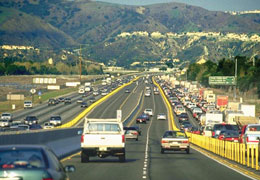Congestion Pricing — A Primer: OverviewExamples in the United StatesHOT Lanes on I-15 in San Diego, California
Photo. Image of plastic pylons separating the priced lanes from the free lanes on State Route 91 in Orange County, CA, clearly showing that there is far less traffic in the priced lanes than there is in the free lanes.
Plastic pylons separate priced lanes from free lanes on State Route 91. Since 1998, single-occupant vehicles pay a per-trip fee each time they use the I-15 HOT lanes.3 Tolls vary "dynamically" with the level of traffic demand on the lanes. Fees vary in 25-cent increments as often as every 6 minutes to help maintain free-flow traffic conditions on the HOT lanes. The project generates $2 million in revenue annually, about one-half of which is used to support transit service in the corridor. SR 91 Express Lanes in Orange County, CaliforniaThe four variably priced express lanes in the median of the State Route 91 Freeway opened in December 1995.4 The toll schedule is adjusted every 3 months based on traffic observed over the 3-month period. Speeds are 60–65 mph on the express lanes, whereas congestion on the free lanes has reduced average peak hour speeds to no more than 15–20 mph. During the peak hour, which occurs on Friday afternoon (5:00–6:00 p.m.) in the eastbound direction, the two "managed" express lanes each carry almost twice as many vehicles per lane than do the free lanes because of the effect of severe congestion on vehicle throughput in the free lanes. Toll revenues have been adequate to pay for construction and operating costs. In fact, in 2003 the private company that had the franchise to build and operate the facility sold the franchise to the Orange County Transportation Authority for a profit. Bridge Pricing in Lee County, Florida
The sign shows "shoulder" time periods when discount tolls are in effect on two bridges in Ft. Myers. Variable pricing began August 3, 1998, on the Midpoint and Cape Coral toll bridges in Lee County, Florida.5 Bridge travelers are offered a 50-percent discount on their toll if they travel during specific discount periods and pay their toll electronically. The discount periods are from 6:30 p.m. to 7:00 a.m., from 9:00 a.m. to 11:00 a.m., from 2:00 p.m. to 4:00 p.m., and from 6:30 p.m. to 7:00 p.m. This toll structure was developed to encourage drivers to shift from peak periods to discount periods. Oregon's Mileage-Based Pricing TestThe State of Oregon has studied an approach that would allow area-wide pricing with smaller expenditures on roadside infrastructure. The study focused on mileage-based fees and peak-period driving charges designed to reduce traffic during the most congested periods while at the same time raising revenue to replace existing fuel-based fees. GPS-based technology was also tested.6 |
|
United States Department of Transportation - Federal Highway Administration |
||